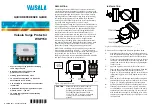
Adjusting the image
Mirage M Series User Manual
92
020-101942-02 Rev. 1 (10-2018)
increase so that whites remain bright but are not distorted or tinted, and that light areas do not
become white. If the environment lighting changes, an adjustment of Gamma is recommended.
•
Brightness
—Increases or decreases the amount of black in the image (0-100). For best
results, keep close to 50. Start with a high value and decrease so that dark areas do not
become black. Conversely, high brightness changes black to dark grey, causing washed-out
images.
•
Yellow Notch Filter
—Yellow Notch Filer (YNF) is a channel based control with an additional
global control, which honors the last request. After enabling YNF, switching to a channel that
does not use YNF and the YNF filter is removed or disabled. Changes to the global control affect
the YNF filter.
•
Color Space
—Determines how the color components of an analog input signal are decoded for
accurate color in the display. Useful only for analog signals and certain digital sources
.
Although
color space for these analog signals is automatically determined by the projector. You may want
to override this and manually set a color space. For some signals, the color space function is
entirely automatic and the list is disabled.
Configure the video sources
The
Video Options
submenu is used with video sources only.
•
Enable Decoder (AGC)—
AGC affects decoded video images only. Enter a check mark
(default) in most instances. Activate the decoder’s AGC circuit to ensure properly bright
images. Delete the check mark if a decoded video image exhibits strange color artifacts such as
stripes in highly saturated colors, indicating an incompatibility between this source and the
AGC.
•
Video Standard—
For most available video standards, the projector automatically detects the
incoming horizontal and vertical frequencies and sets the projector’s processing of this signal to
the corresponding standard. The current video standard name appears in the
Video Options
submenu, and includes an A if it is auto-detected. Press
Enter
to view or select a different
video standard from those available to the projector; any that are disabled have frequency
characteristics that differ from those of the incoming signal. Selecting a specific standard forces
the projector to process the signal according to this standard.
Best results are obtained with defined channels. Otherwise, switching from one video source to
another can sometimes cause slight disturbances in the display, indicating that the Auto
function is struggling. Recover by briefly selecting a different video standard, then going back.
Standard
Where used (subject to change)
PAL
Most of Europe, China, Australia, some of South America, some of Africa
NTSC
North America and Japan
SECAM
France, Eastern Europe, most of Africa
NTSC 4.43
A tape-only standard for partially-translated hybrid signals
PAL-M
Brazil
PAL-NC
Argentina, Chile, other Latin American countries
http://www.pureglare.com.au
















































